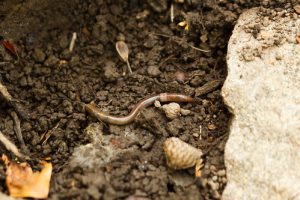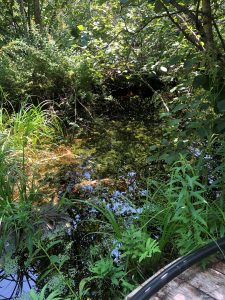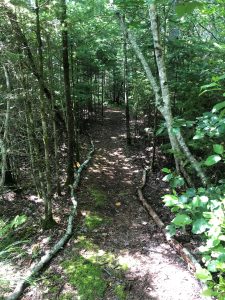Master Gardener Volunteers Newsletter – September 2023
Table of Contents
MASTER GARDENER BOOK GROUP / JUMPING WORMS/ MG PROJECT PROFILE/ UPDATE OF MGV PROGRAM / NEEDS ASSESSMENT SURVEY/ ON-LINE TRAININGS AVAILABLE
Upcoming Dates to Remember!
Date TBD – Planning is underway for our Fall MGV Recognition – Watch your emails for updates!
Sept 17th – Needs Assessment Survey ends (see article end of newsletter)
REMINDER! Report Your Master Gardener Hours
As the 2023 growing season is wrapping up soon, please remember to report your MGV Hours! It is important to report your hours so that new (2022/2023 MGV’s) are presented with their MGV Certificates, and for veteran MGV’s, completing at least 20 hours, to receive end of year earned incentives such as hats, t-shirts, or the super popular Lapel Pins!
MASTER GARDENER BOOK GROUP
The MGV Book Group convenes the 2023-24 season on September 21st at 9:00 a.m. at the
Moore Center on State Street in Ellsworth. Newcomers are always welcome! Our meetings are
in-person. We have an eclectic and interesting selection of books to read this season, listed
below. The books are all available through our local libraries and bookstores.
For more information contact Jane Ham, jdham48@gmail.com.
September 21, 2023 – Seed to Dust: Life, Nature, and a Country Garden by Marc Hamer
The author paints a beautiful portrait of the garden that “belongs to everyone.” He describes a
year in his life as a country gardener with each chapter named for the month he’s in.
October 19, 2023 – Pod: A Novel by Leline Paul
An astonishing and immersive new novel, Pod takes the reader into the depths of the ocean-
and into the world of its fascinating inhabitants-through the eyes of the beautiful EA, a spinner
dolphin.
November 16, 2023 – Genius of Place : The Life of Frederick Law Olmsted by Justin Martin
Frederick Law Olmsted is arguably the most important historical figure that the average
American knows the least about. Best remembered for his landscape architecture, from New
York’s Central Park to Boston’s Emerald Necklace to Stanford University’s campus, Olmsted was
also an influential journalist, early voice for the environment, and an abolitionist.
January 18, 2024 – Illumination in the Flatwoods by Joe Hutto
When Joe Hutto began his experiment in imprinting two dozen wild turkey—in the tradition of
the great animal behaviorist, Konrad Lorenz—he had no idea that it would change his life. Told
with skill and humor, and vibrating with the natural wonders of the Florida flatwoods,
Illumination in the Flatwoods will amaze and enrich all who share this season with the wild
turkey.
February 15, 2024 – An Immense World by Ed Yong
NEW YORK TIMES BESTSELLER • A “thrilling” (The New York Times), “dazzling” (The Wall Street
Journal) tour of the radically different ways that animals perceive the world that will fill you
with wonder.
March 21, 2024 – Nature’s Temples by Joan Maloof
An old-growth forest is one that has formed naturally over a long period of time with little or no
disturbance from humankind. They are increasingly rare and largely misunderstood. In Nature’s
Temples, Joan Maloof, the director of the Old-Growth Forest Network, makes a heartfelt and
passionate case for their importance and forever alter your perspective.
April 18, 2024 – The Heirloom Gardener by John Forti
John Forti celebrates gardening as a craft and shares the lore and traditional practices that link
us with our environment and with each other. Charmingly illustrated and brimming with
wisdom, this guide will inspire you to slow down, recharge, and reconnect.
JUMPING WORMS
Get to know them – they are here to stay
What are they?
Officially they are called Asian jumping worms (Amynthas agrestis). They are invasive and as their name suggests, they are not native to the US. The name ‘jumping worms’ was derived from their behavior of moving in an ‘S’ pattern and seeming to be elevate from the ground when disturbed. I can tell you first-hand that they are very wiggly, and very fast. Check out this JUMPING WORMS FACTS SHEET
What do they look like?


Where do they come from?
They are native to East Asia. They are now in home gardens, woodlands, and ecosystems throughout the country. They often arrive at homes and nurseries in potting soil, mulch, or compost from an outside source. They can be in the soil of plants or trees you purchase. The latter is the reason that the Extension Office asks for donated plants to be delivered bare-root.
Why are they bad?
Jumping worms change the soil by accelerating the decomposition of leaf litter on the forest floor. They turn good soil into grainy, dry worm castings (aka poop) that cannot support the native understory plants of our forests. Other native plants, fungi, invertebrates, and vertebrates may decline because the forest and its soils can no longer support them. As native species decline, invasive plants may take their place and further exacerbate the loss of species diversity.
In nurseries and greenhouses, Amynthas worms reduce the functionality of soils and planting media and cause severe drought symptoms. After irrigating or rains, you may find these worms under pots. These worms may be inadvertently moved to new areas with nursery stock, or in soil, mulch, or compost.
Many of Maine’s forests are already under pressure from invasive insect pests, invasive plants, pathogens, and diseases. Amynthas worms may cause long-term effects on our forests.
What now?
Check your own property.
The worms stay in the top 1-2 inches of the soil, so just scratching the surface of the soil with (gloved) hands or a hand cultivator will uncover them. They will also come to the surface after a heavy rain; or you can mix ¼ cup of dry, ground yellow mustard with a gallon of water and pour it on the soil. The mustard should irritate the worms and they will come to the surface.
Look for the band about 1/3 of the way from the head (clitellum) to be milky white and not raised, as well as the typical thrashing behavior and snake-like crawling. Then dispatch them in one of the following ways:
- Put them in a sealed plastic bag or container that can be placed in the freezer or left outside in the sun;
- Put them in a heat-proof container and pour boiling water over them. They will turn white.
- Drop them in a bucket of soapy water and leave it outside.
When you are sure they are dead, throw them away. This may take a few days, depending on the method you use. Do not compost or bury them.
Fishermen love to use them because they are so wiggly. Encourage them to dispose of them properly, or dispense using them altogether.
Finding jumping worms in your garden can cause real emotional issues. The Univ. of Minnesota has a good, short piece on managing grief: Emotional Support for those with Jumping Worms
If you find jumping worms in your gardens, Submit a Maine Jumping Worm Report
or contact IPM entomologist Hillary Peterson at Hillary.peterson@maine.gov for help with identification and next steps.
Finally, scared of worms? There’s a word for that! Scoleciphobia is the irrational fear of worms.
MGV – PROJECT PROFILE
Native Gardens of Blue Hill and Blue Hill Community Garden Visits!

On July 28th, a small group of Master Garden Volunteers met at the Bagaduce Music Lending Library for a tour of the Native Gardens of Blue Hill (NGBH). The public gardens are a result of a cooperative agreement between the Library and NGBH for NGBH to transform the Library’s four acre property of large swaths of dirt drive/ parking areas, woods, and buildings into a sustainable, ecologically sound habitat. The landscape design utilizes only Maine native plants in restoring the property.
At the time of our visit, the short entrance off of South Street to the property was typical of a Maine summer scene — dust, broken pavement and road construction, but once the entrance was crossed the scene became one of a creation in progress and inspiration with native plants everywhere, volunteers weeding, tending and preparing still another area for a new installation. The Library’s complex of buildings and connecting walkways are landscaped with an array of beautiful small gardens of native plants each tailored to thrive in the various site conditions including downpour run-off. The remainder of the

property, some of which was originally a parking area, includes a myriad of intertwining gardens, woods, and a magical woodland trail leading from a green roofed open pavilion to a small pond. Maine native plants are beautiful! For a detailed description of the overall design and plants used in each area, see the NGBH website nativemainegardens.org
Rachel Emus, MGV and Garden Manager, led us on the tour; Avy Claire and Cathy Rees, founders of NGBH, joined us in a lively informal discussion under the pavilion. The gardens, designed by NGBH, are maintained in every aspect by volunteers and MGV volunteers are welcomed! Current work sessions are every other Friday morning. See the NGBH website for information including educational events.
After the Native Gardens tour, Rachel changed her hats and led us to the Blue Hill Community Garden, located on Tenney Hill. This garden is about 1600 square feet, located on land owned by George Stevens Academy (GSA), and started and installed by

the Blue Hill Garden Club in collaboration with Healthy Acadia. The vegetables are grown by the club from seed with the help of GSA students and harvested and distributed by Healthy Acadia’s gleaning initiative. (Rachel manages Healthy Acadia’s food programs.) The garden is fenced and conveniently located in the downtown area for people to pick their own, and provides produce for the Magic Food Bus, Simmering Pot, and Tree of Life. There were more than 40 types of vegetables growing in neatly raised and mulched rows, including tomatoes, peppers, herbs, kale, onions, and potatoes. During a discussion led by Rachel, the group had many questions, particularly about how to sustain this and other community projects that are dependent upon a volunteer work force. The garden joins the ever-growing network of public vegetable gardens. Check it out when you are in Blue Hill, and consider volunteering!
UPDATE ~ MASTER GARDENER VOLUNTEER PROGRAM
The following is a letter sent to all MGVs from our Home Hort Team regarding our MGV program in Hancock and Washington Counties.
Hello Hancock and Washington MGVs,
We wanted to reach out and make sure you had information on resources for your Master Gardener Volunteers and projects, all in one place, and address some questions we’ve been getting:
- You can still get credit for volunteering! Please continue to report your hours through our statewide reporting hours reporting form.
- We will continue to re-approve existing projects on an annual basis. Be on the lookout for a new statewide process for us to track and communicate with approved projects coming this fall!
- Similarly, we’ll reach out to all enrolled volunteers to re-enroll in the new year so keep an eye out for that in 2024!
- We are committed to continuing to attend MGV advisory board meetings (if applicable to your county) to keep you in the loop about updates from the statewide program.
- We will continue to communicate via a statewide newsletter that goes out to all MGVs (and we’re going to try to send those out more frequently!)
- We’ll continue to support Harvest for Hunger projects by funding supplies. Reach out to extension.harvestforhunger@maine.edu with funding requests or questions. Please continue to report food gleans and donations through our statewide form!
- If you need materials for non-Harvest for Hunger projects, reach out to your local admin and they will work with Pamela and Becca to fill needs.
Where to go with questions:
- Your county office administrative support staff are a good first stop for questions!
- Hancock: Sue Baez, sue.baez@maine.edu
- Washington: Tara Wood, tara.a.wood@maine.edu and Deb Gardner, deborah.gardner@maine.edu
- Harvest for Hunger project funding, gleaning, food donation questions: extension.harvestforhunger@maine.edu
- Questions about individual hours/enrollments: Becky Gray, Extension.mastergardeners@maine.edu
- Technical questions about projects (disease, insect, other issues): Rebecca Long and Pamela Hargest, Extension.mastergardeners@maine.edu
Sincerely,
Rebecca Long and Pamela Hargest
Home Horticulture Co-Chairs
UMAINE EXTENSION – NEEDS ASSESSMENT SURVEY – Reminder!
UMaine Extension Statewide Community Needs Assessment Data Collection Portal is still available for your input until September 17. If you have already completed the previous version of the portal, you don’t need to resubmit; we have your data. If you would like to resubmit, please check the question in the portal that asks if you completed a previous version of the portal questions.
I’ve included the portal link below and essential information about the portal. I also attached a document with some recommended language to use as you contact interested groups and people. To remind you, the portal is meant to be filled out by those familiar with UMaine Extension.
UMaine Extension Statewide Community Needs Assessment Data Collection Portal (LINK)
2023-2024 ONLINE TRAINING PROGRAMS (share with your contacts!):
- Maine Gardener Training: Designed for gardeners who desire a foundation in basic horticulture education and skills for personal use. Recommended for those who would like to access the educational content of the Master Gardener Volunteer training program but do not plan to volunteer. Enrollment for the 2023-2024 training program will open on Tuesday, October 10, 2023 at 12:00 PM and close on Monday, October 23, 2023 at 4:30 PM or when capacity has been reached, whichever is sooner. The course will begin on Monday, November 6, 2023.
- Maine Horticulture Apprentice Training: Designed for learners interested in exploring a career in horticulture, whether an entry level employee, a high school student, or those interested in changing their career path, it is designed to supply learners with a foundational horticulture education suitable for skilled entry-level positions in the horticulture industry. Developed with input from horticulture industry leaders, this program will prepare learners with the practical horticulture knowledge and skills desired by employers and earn a University of Maine micro-credential. Enrollment for the 2023-2024 training program will open on Monday, October 3, 2023 at noon and will close on Monday, October 23, 2023 at 4:30pm, or when capacity has been reached, whichever is sooner. The course will begin on Monday, October 30, 2023.
IN-PERSON PROGRAM
- Maine Hunger Dialogue and Climate Action Summit (Orono): Wednesday, October 11, 8:30 a.m.-5:00 p.m. Sliding scale program fee, $0-$50. Register online here.
DO YOU KNOW
-Someone who inspires your gardening?
-Someone who is making a difference environmentally, food security, climate change mitigation – whether quietly
or loudly in one small plot or large project?
IF SO
– We want to know, here is one way to tell us
MGVnewsletterinput@gmail.com
Our MGV newsletter is for and about Washington/Hancock MGV people, projects, and community. MGVnewsletterinput@gmail.com, was established as a way for readers to recommend interesting topics or people for future articles, provide comments or ask questions. It has been a little used resource, but for some of you it has been a way to not only give input to the newsletter committee, but also to make suggestions for Continuing Education and MGV projects. Try it!
This month’s newsletter sent by Sue includes articles from our new “Communicate with MGV’s” task force. We’d like the next edition to feature your suggestions and articles about gardeners and gardens. MGV’s, please contact us at MGVnewsletterinput@gmail.com with your ideas.
Thank you from
Betsy Adams, Jan M., Jane, Wendy, Linda, Mary D., Mary H., and Rita
